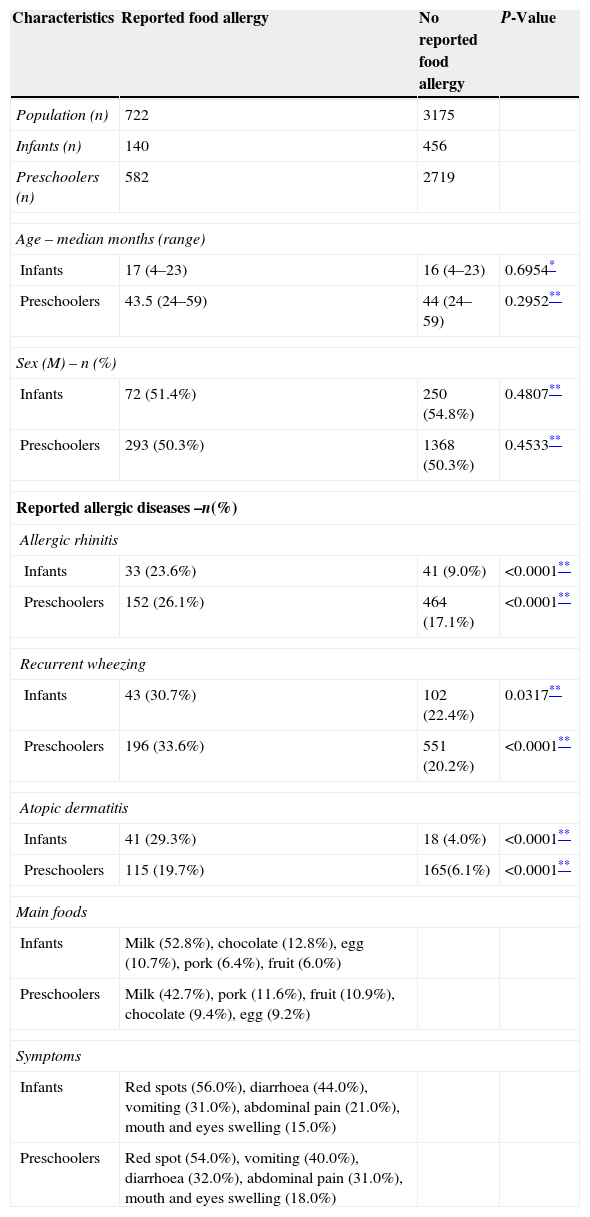We have read with great interest the comments on the studies recently published “Prevalence of parent-reported immediate hypersensitivity food allergy in Chilean school-aged children”1 and “Epidemiology of food allergy in Latin America”.2 We are very grateful to the authors for the opportunity that our colleagues bring us to add some data.
In Uberlândia, Brazil, we are finalising a cross-sectional study which evaluated the frequency of parental reported food allergy in infants and preschoolers. The study enrolled all children aged 4 to 59 months in the Public School District for Early Childhood Education. A validated FA screening self-administered questionnaire was applied.3 The questionnaires were delivered to all district schools in the city and to the parents, and after appropriate filling, were returned to the school office where they were collected by the researchers. This study constitutes the first phase of a larger research project entitled “Prevalence of food allergy in infants and preschoolers Uberlândia”, which consists of clinical and laboratory evaluation of children with suspected food allergy reported by parents in order to determine the prevalence of food allergy for these ages groups.
Of the 9265 children enrolled, 3897 parents answered the questionnaire (response rate of 47.9%). The prevalence of food allergy reported by parents obtained was 23.5% in infants and 17.6% in preschoolers. The frequency of positive response to the presence of other types of allergies in the groups with reported and non-reported food allergy was significant higher for allergic rhinitis, atopic dermatitis and recurrent wheezing in the group with reported food allergy, as shown in Table 1.
Demographic and clinical characteristics of the study population (n=3897).
| Characteristics | Reported food allergy | No reported food allergy | P-Value |
|---|---|---|---|
| Population (n) | 722 | 3175 | |
| Infants (n) | 140 | 456 | |
| Preschoolers (n) | 582 | 2719 | |
| Age – median months (range) | |||
| Infants | 17 (4–23) | 16 (4–23) | 0.6954* |
| Preschoolers | 43.5 (24–59) | 44 (24–59) | 0.2952** |
| Sex (M) – n (%) | |||
| Infants | 72 (51.4%) | 250 (54.8%) | 0.4807** |
| Preschoolers | 293 (50.3%) | 1368 (50.3%) | 0.4533** |
| Reported allergic diseases –n(%) | |||
| Allergic rhinitis | |||
| Infants | 33 (23.6%) | 41 (9.0%) | <0.0001** |
| Preschoolers | 152 (26.1%) | 464 (17.1%) | <0.0001** |
| Recurrent wheezing | |||
| Infants | 43 (30.7%) | 102 (22.4%) | 0.0317** |
| Preschoolers | 196 (33.6%) | 551 (20.2%) | <0.0001** |
| Atopic dermatitis | |||
| Infants | 41 (29.3%) | 18 (4.0%) | <0.0001** |
| Preschoolers | 115 (19.7%) | 165(6.1%) | <0.0001** |
| Main foods | |||
| Infants | Milk (52.8%), chocolate (12.8%), egg (10.7%), pork (6.4%), fruit (6.0%) | ||
| Preschoolers | Milk (42.7%), pork (11.6%), fruit (10.9%), chocolate (9.4%), egg (9.2%) | ||
| Symptoms | |||
| Infants | Red spots (56.0%), diarrhoea (44.0%), vomiting (31.0%), abdominal pain (21.0%), mouth and eyes swelling (15.0%) | ||
| Preschoolers | Red spot (54.0%), vomiting (40.0%), diarrhoea (32.0%), abdominal pain (31.0%), mouth and eyes swelling (18.0%) | ||
The main food mentioned in this study was cow's milk, with a frequency of 52.8% in infants and 42.7% in preschoolers. The other foods most cited in infants were chocolate (12.8%), hen's egg (10.7%), pork (6.4%) and fruits (6.0%); while in preschoolers, the other foods most frequently cited were similar, but in a different order, pork (11.6%), fruit (10.9%), chocolate (9.4%) and hen's egg (9.2%) (Table 1).
The symptoms described by parents in association with a positive response to food allergies were very similar in infants and preschoolers, and were: red spots, diarrhoea, vomiting, abdominal pain and swelling in the mouth and eyes (Table 1).
The study of the epidemiology of food allergy by different regions of the world is extremely important, since there may be variations in food allergy related by cultural differences and feeding patterns of each country.
The frequency of parental reported food allergy in the present study was superior than that found in school-aged Chilean (13%)1 and similar to that found by a previous meta-analysis (3–35%)2 showing the variations around the world related with a perception of food allergy. The frequency of recurrent wheezing, rhinitis and dermatitis was significantly higher in the group of children with food allergies, and these data were similar to those obtained in Chile1 and Cartagena4 studies. This probably occurred because parents of patients with diagnosis of other allergies are more likely to feel that their children are allergic to some food.
In relation to the foods associated with the perception of food allergy, in Brazil, the perception of cow's milk allergy was twice that found in Chile1 (25%), probably by cultural aspects of Brazilian society. One food frequently reported in Brazil was pork, which was not cited in the Chilean study. The foods most frequently reported by parents as causing recurrent symptoms are similar to those observed in prevalence surveys of self-reported food allergy made in Italy, Lithuania, USA, Germany and Portugal.4,5 The symptoms were also similar to those reported in the literature (Table 1).4,5
Importantly, studies of Brazil, Chile and Colombia had differences. The Colombian study target population ages 1–83 years with any reaction to foods. In Chile, the target population was scholars with only immediate hypersensitivity reactions to foods. In Brazil, the target population was infants and preschoolers with any reaction to foods. These differences lessen the ability to compare studies, but without taking away the importance of each one.
The main foods reported by parents in the Brazilian study are part of the usual diet and the knowledge of family perception is important to avoid unnecessary dietary restrictions and impaired growth and development of children.





